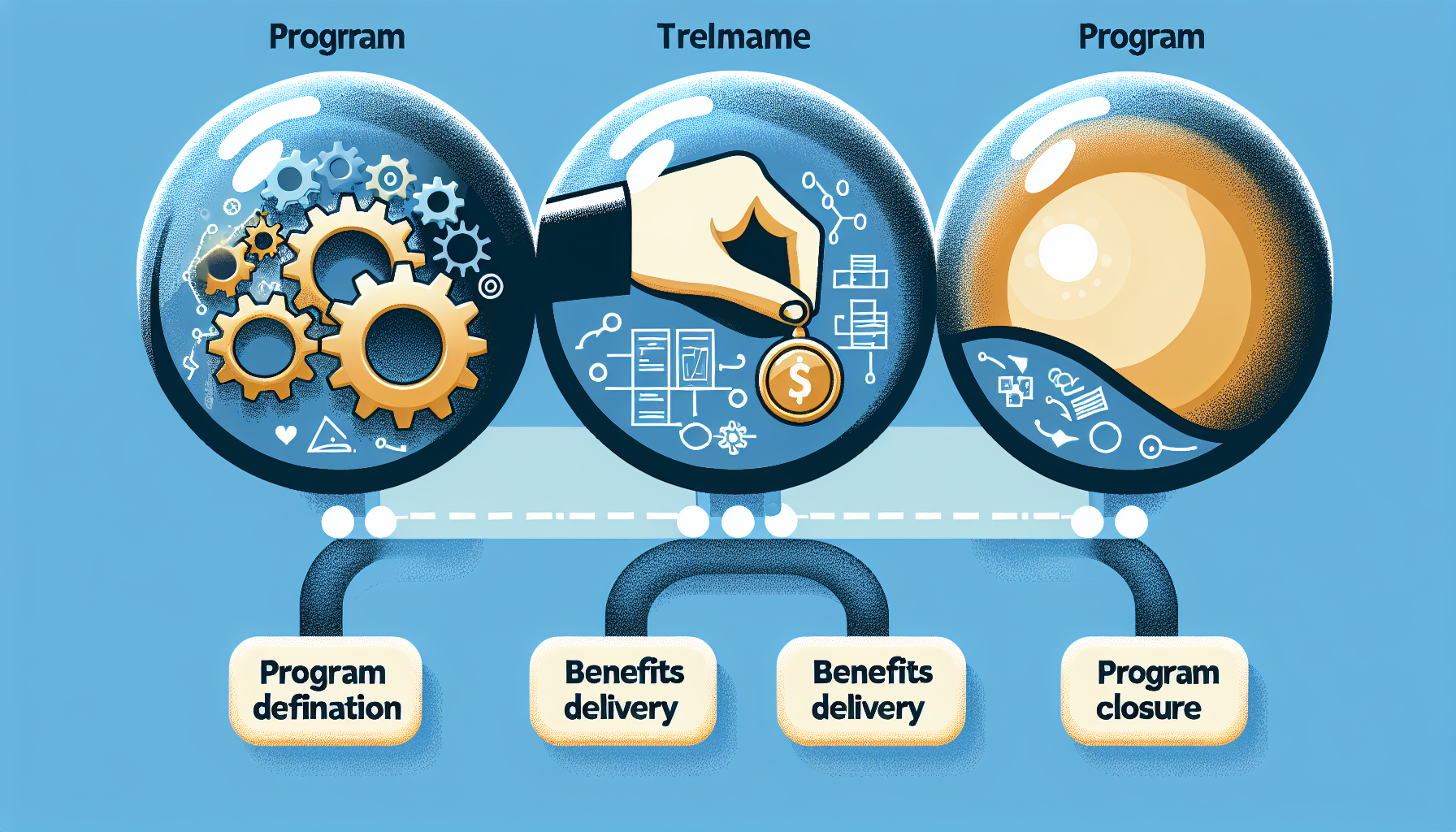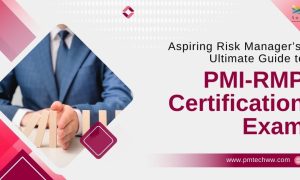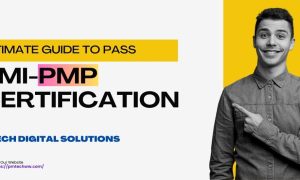Are you tasked with overseeing complex programs? Grasping the components of program management is crucial for success. This article breaks down the essentials – from strategic alignment to stakeholder communication and risk management – equipping you with the knowledge to master program management and achieve your business aims.
Key Takeaways
- Program management involves strategic alignment of multiple projects to deliver shared organizational goals, necessitating robust governance and efficient lifecycle management through definition, delivery, and closure phases.
- Effective program management relies on detailed planning, which includes resource allocation, stakeholder communication, and risk management, to support structured communication and successful program execution.
- Leadership within program management is crucial for steering organizational change and for mentoring teams, while the evaluation of program outcomes helps in measuring business benefits and reflecting on lessons learned for continuous improvement.
Understanding the Core Elements of Program Management
Think of an experienced piano player, hands elegantly placed over the piano keys, prepared to play complex symphony. This pianist in the program management represents a program manager and each key illustrates a significant aspect of effective program management. Just as the piano keys are being played in perfect harmony, the program manager should comfortably link and coordinate numerous projects that are related.
The ultimate goal? Efficaciously accomplishing common organizational goals that reverberate across all measures of the organization. It is here where proper utilization of programs and project management in an effective and strategic manner plays an important role in success for everyone.

The program manager is to implement the strong program management processes, which will enable him or her to integrate and coordinate these several related projects, ensuring that project objectives are aligned with the overall business goals.
Defining the Program’s Strategic Alignment
The melody characterizes a symphony, just as strategic alignment is the rock upon which program management is built in order to ensure that every project that is pursued contributes to the business objectives of the overall organization. This key alignment is similar to striking a perfect chord on the piano, which produces a harmonious melody.
Program Governance Structure
Like a conductor that leads an orchestra in performing a symphony, programs must have a good governance framework that they are in alignment with the organization’s strategy. This is the point where the governing board comes into play to introduce successful governance practices and to approve new programs with their budgets and track their progress for the entire program success.
Program Lifecycle Phases
Similar to a symphony with its distinct movements, the program life cycle is composed of three phases: program definition, benefits delivery, and program termination. Every stage has specific speed and meaning.
During the Program Definition phase, the team develops the business case for the program, translates strategic goals into implementable activities, and formulates an overall program plan to steer its direction. The second phase is the Benefits Delivery which starts initiating and planning the elements of individual projects within the broader scale of accomplishing the overall goals. It also includes the integration of outcomes from different projects and tracking the progress in achieving the expected benefits.

The final stage is referred to as the Closure Phase, meant to facilitate a smooth exit out of the program. With the controlled and orderly manner, it relates to intentional cessation of the program, focusing on best practices in transition the benefits to ongoing operational activities, release of resources, and dissolution of program teams. All three phases need to be managed with proficiency otherwise a program is not going to be delivered successfully and it should be noted that it is like a symphony that in order to work right has to be handled with patience, perseverance, and competence.
Crafting the Program Management Plan
The process of development of the program management plan is similar to writing a symphony. It demands comprehensive thought, elaborate planning, and a lucid picture of the anticipated outcome. The plan also ensures proper communication among the concerned parties thus, it eliminates misinterpretation and subsequently, the risk of deadlines’ breach. Successful implementation of the project can be guaranteed by adherence to well-defined project management process.
This method ensure resources are spread rightly throughout all the stages in the program still within the budget limits. It allows the time saving, makes prediction.
The introduction of project management software into this process will considerably improve the development and control of a program management plan and provide an integrated system for resource management, scheduling and communication at all program management levels.

Resource Management Strategies
In program management, resource management is like the conductor who coordinates each instrument in an orchestra for the success of the symphony. It includes proper management of different resources that are labor, materials, equipment, facilities and finances in order to achieve team performance. Project management software integration is significant in the improvement of resource management approaches across several projects since it enables the management of scheduling, costs, budget, resource allocation, and task management without modification of data structure for different roles and support effective communication across all levels of program management.
Resource management strategies involve categorizing, allocating, controlling, and releasing of various types of resources. This involves developing an all-inclusive list used to quantify costs and forecast processes. It also involves effective human resource management through issues of availability, modularity, competence, communication ability and so on. The third area for consideration in programs is an appropriate allocation of these resources across several projects.
A properly designed resource management plan offers instructions on managing all the resources present. It includes the processes of identifying, re-allotting, maintaining or purchasing the new required assets. The plans also consider the human capital critical unique considerations. Factors such as the expertise level, level of flexibility, knowledge level, stature etc. should be paramount while appraising the contributions of project teams. Moreover, a key theme would be to determine an equilibrium in the allocation of common finite elements between various ongoing works. In total, this is why the control over allocated apparatuses altogether with some elements are factors of the successful implementation.
Communication and Stakeholder Engagement
The communication process within a program may be likened to the rhythm of a symphony. Like an orchestra that needs constant and well defined rhythms, communication is on the other hand an indispensable tool of success in any program.
In order to address the needs of various stakeholders and the levels of influence in a program, program managers need to adapt their styles and approaches of communication. Stakeholders informative and interactive updates through different media are very important to build relationships based on trust, rapport and appreciation of the stakeholders’ input.
Risk and Issue Management Protocols
Risk management in a program is like a safety net for an acrobat. It includes recognizing, evaluating, response planning and tracking of anticipated threats or barriers that can compromise the program’s objectives. A thorough risk management plan should outline procedures for:
- Identifying potential risks
- Analyzing their likelihood and impact
- Ranking them by priority
- Determining appropriate response strategies
Likewise, efficient issue management procedures include setting up ways for rapidly documenting, monitoring and addressing issues as they occur to prevent Complications. Regular intervals review meetings with key members of the program team can monitor the current risk statuses and review response plans on time.
Further Reading: Risk Management: Ultimate Guide to Navigating Uncertainties
Coordinating Project Portfolio Management
To manage a project portfolio is similar to performing an orchestra in a sense of choosing and prioritizing the right musical pieces for a concert. Similar to the role of the conductor where every piece he/she has chosen should work together to create the overall theme of the presentation and make an enjoyable experience for the audience, program management aligns multiple projects to meet company goals.
When it comes to program management vs project portfolio management, it is necessary to be aware that while both try to link projects with strategic objectives, in the context of program management, it is emphasized on the unification and coordination of projects to achieve long-term goals. However, project portfolio management is more targeted towards selection and arrangement of which projects should be performed by taking into account their criticality in respect to overall objectives.

Balancing Project Interdependencies
For harmonious music, a symphony needs variation of melody, harmony, rhythm, and texture, and a project should also maintain balance of project interdependencies for successful execution. Task dependencies within projects are identified and managed by program managers.
Programs can suffer due to various types of project dependencies, including logical, which come in a sequential order, commands, and those connected with resources required. Cross-team collaborations may also be required or there may be external factors that are not within the team’s jurisdiction. Consideration should be given to the internal linkages between different elements of each individual project and the preferential dependencies that could affect the process that will make the final decisions.
Hence, harmony in operations and successful completion of projects should be maintained, hence all interconnected dependencies should be tracked and demonstrated by the program managers. Another important feature to be used in the project management is critical path calculations, as they provide vital input in ranking tasks relative importance in attaining the overall objectives.
Tracking Progress and Performance
Assessment of progress and accomplishment in management of a program requires analysis of different elements such as time, cost, resource utilization and milestone completion. This tracking enables the measurement of the program outcomes that everything is on track.
There are different methods for tracking projects such as:
- Utilizing quantitative measurements with numerical metrics
- Employing qualitative techniques like team meetings or surveys
- Using reporting tools and analytics to continuously monitor progress
The above tracking performance processes need continuous monitoring and improvements to adjust to changing regulations, technologies, and business approaches. In this way, the project managers’ goals are achieved.
Implementing Effective Work Management Practices
Practicing work management principles efficiently within a program is like that of the rehearsal process of an orchestra, where each section must master its part individually before merging together for the final performance. Also, proper project management is critical in making a program successful as every project is part of the whole and contributes to the overall goals and objectives.
As every section is in an orchestra has its own role, the same way a project should be carefully organized and handled in order to bring value to the overall execution of the program.
Managing Program-Level Workflows
In the world of music, a conductor is required to manage the workflow of an orchestra well and to bring about harmony in a symphony. Program management, in the same way, consolidates different features including end-to-end processes, people, digital workers, systems, and data at a program level. For success, it is important that decisions and progress review should be based on the whole program but not individual projects.
A committed Program Management Office (PgMO) can offer the necessary assistance and hand-holding through the process of orchestration by introducing right processes. The role played by a practitioner in program management is critical, more so when it is compared to other approaches recommended by organizations such as the Project Management Institute (PMI).
The initial move towards effective orchestration of workflows is to gain an unbiased perception of how the current-state workflows works and identify where changes can be made. In order to control the relationship between tasks within individual projects that fall under one umbrella – the overall program – managers employ various types of task relationships, such as the finish to start, start to finish, finish to finish, or start to start methods based on their requirements.
The attainment of the credential of Program Management Professional (PgMP) marks the practitioner’s successful mastery of such histories, thus underscoring the value of certification as an indicator of the commitment of a practitioner to the field of program management.
Enhancing Team Collaboration
In program management, an ensemble working as one is critical to success, as an orchestra performing a symphony. Proper teamwork among the staff members leads to knowledge sharing and problem-solving skills that in turn makes the team to be more productive and efficient.
A program manager plays the role of a critical figure in program management; thus, he/she is tasked with creating a team spirit where there is continuous communication as well as set goals and shared respect. Creating an environment where questions are encouraged and different viewpoints are appreciated enables utilizing the different backgrounds and cultures on the team.
Utilizing Software Tools for Program Success
Similarly, software tools have the same effect on program management in that they automate certain tasks just as a conductor can improve an orchestra’s performance. Most of these software do time tracking, cost metrics monitoring and team member utilization, facilitating the collection of data and resources allocation for managers.
In other words, these software solutions serve as assistants to program managers, enabling them to concentrate on the nitty-gritty of their programs, without having to contend with administrative tasks.

In addition, the project management software helps the project managers to manage the resources, scheduling, as well as task management across the various projects within a program, such that each project aligns with the overall program objectives.
Selecting the Right Program Management Software
Selection of the right software for program management is akin to the conductor who is very choosy about the instruments for his orchestra. The selected software should help in the planning and scheduling, promoting the creation and tracking of critical tasks and project timelines.
Advanced resources management is a key aspect of efficient program management software. This enables effective utilization and allocation of equipment, personnel, and materials between different projects. Smart progress tracking provides comprehensive status over the timelines of the project that help in early identification of issues and keep the overall health of the project.
Further Reading: Best Alternatives of Microsoft Project: For Streamlined Project Management in 2024
Integrating Technology into Program Operations
In that light, the process of integrating technology with the operating of programs can be seen as the conductor who uses state-of-the-art musical instruments to make the orchestra’s performance even better. Utilizing workflow orchestration tools at the program level enables process design and task automation to create more effective workflows.
The data integration across the project management processes allows a unified view that enhances decision-making competence and operational efficiency. Centralizing the collection of metrics associated with project management makes it more seamless and people obtain consistent and good quality data.
The Role of Leadership in Program Management
The conductor plays major role in the world of an orchestra as he or she directs and controls musicians so that they can work in harmony and the result cascades into harmony among the elements in the band. In the same way in program management, the role of a program manager is vital as they seek to harmonize program goals with company objectives while also managing organizational changes.
They are also responsible for mentoring and developing project teams within this structure. PgMP certification is a symbol of a program manager’s dedication to leadership and excellence in program management, setting them apart from project managers and other project management professionals by showcasing their extensive training and experience.
Steering Organizational Change
As a conductor guides an orchestra through tempo changes and melodic variations, program managers are critical in managing the change. They generated, appraise, plan and operationalize adaptations deriving from project’s accomplishments aimed at driving the organizational transformation process. Their crucial role in controlling changes within the organization, program managers form an essential part of its success.
Mentoring and Developing Project Teams
Just like a conductor leads and improves the capabilities of the orchestra members in order for them to be at their very best. Program managers also act as mentors of the project teams while striving for optimal performance. It requires to give project managers and team members support, feedback, and guidance.
The development process involves determining any training needs of people in the team so as to prepare individuals to have the right skills for their roles. By recognizing and commemorating successes as a group, program managers lift the spirit of the team and at the same time emphasize on the importance of team work in attaining the overall goal of the program.
Evaluating Program Management Outcomes
The conductor thinks over the performance of the orchestra after a concert, giving an evaluation of its success and failures. In the same fashion, evaluation of program management outcomes is done by setting realistic objectives, assessing performance indicators, and making regular reviews to monitor achievements.
Measuring Business Benefits
Program management sees the applause as a mark of success of a symphony. Also, in business programs, the attainment of objectives and benefits can be evaluated by way of smart.
Specific, measurable, attainable, relevant, and time-bound (SMART) criteria. The indicators should be in line with the general objectives of the firm in terms of on-time delivery and within budget.
A good plan that specifically defines roles of benefit measurement should be developed to evaluate business benefits in program management. It should also contain short-term projects with defined timelines and an adequate amount of resources to achieve the set objectives. This method will aid in effective assessment of some performance parameters such as delivery time and budget constraint compliance linked with corporate overall objectives.
Reflecting on Lessons Learned
After the performance, a conductor meditates on the lessons that can be picked for future improvements. Likewise, it is when program management results are evaluated, managers can learn from the previous outcomes and use the best practices in future programs.
The stage of program management planning is improved by recognizing past errors which make it possible to detect potential risks and enhance project execution in subsequent projects. Following a systematic methodology in setting goals and appraising performance helps the program managers in step by step evaluation of the accomplishments and obtain useful information that helps in future improvements.
Summary
Just as the final in a symphony leaves its audience inspired and touched, this blog end with the profound realization, that the program management mastery is much like directing a complex orchestration. This harmony is produced by strategic alignment, governance structure, lifecycle phases, work management practices and all these constitute the key melody of success in program management.
Frequently Asked Questions
What are the key components of program management?
Risk evaluation, quality control, change management and stakeholder communication and reporting represent the core elements of program management. This includes three key stages: program definition, benefits delivery, and completion. These components function as a key success factor in proper program management practices.
What are the three pillars of program management?
Program management relies on three main pillars: planning, control, and communication. These elements are crucial in the process of delivering a final product within a project’s scope. Without proper implementation of these pillars, it is impossible to successfully carry out any program or manage any project.
What are the elements of a program management plan?
The scope of the program management plan entails the whole gamut of governing a program, its governance structure, major components, methodologies to achieve benefits and associated processes. It also sets out schedules and methods of proper planning, monitoring and progress control within the program as a whole.
This vital document acts as a complete manual for the efficient management of all components of the program in a systematic way. By detailing multiple ways of dealing with the different aspects of running a successful operation in the context of unity, the document provides a necessary guidance in order to reach the desired results and at the same time, remain in the effective control of the project process.
What is the importance of strategic alignment in program management?
Program management strategic alignment importance stems from the fact that it ensures that all projects are in line with the primary business goals of the organization and therefore improve their overall efficiency. With this approach, programs are able to collaborate and support each other to the realization of common goals under a single management system.
How does a robust governance framework contribute to program management?
An effective governance framework is essential for successful program management as it facilitates efficient decision-making, ensures program activities are in line with organizational objectives, and establishes suitable components within the program.




